American Staffordshire Terriers
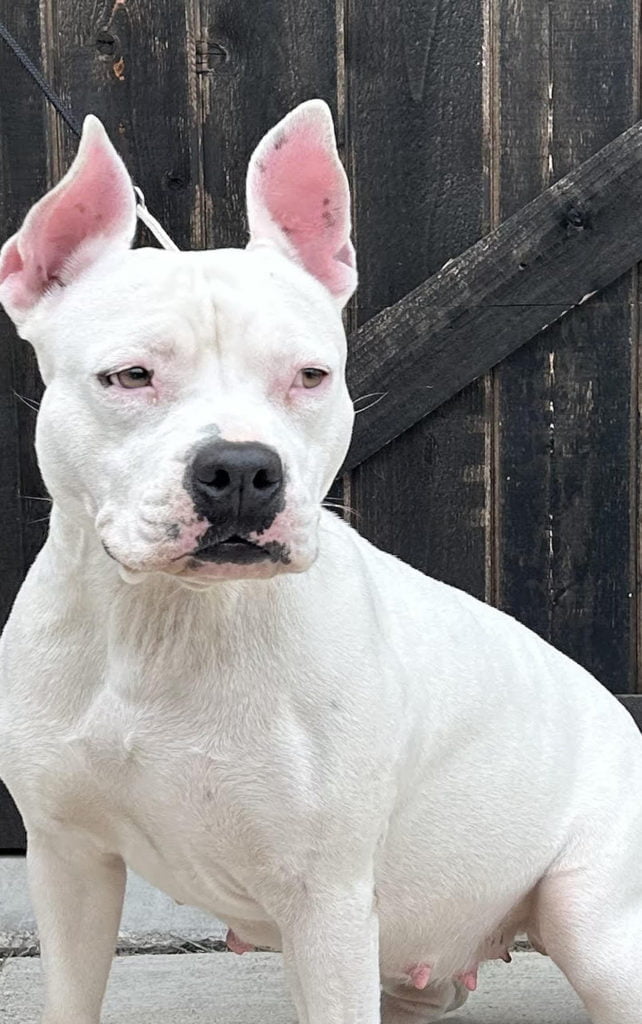
Unveiling the Charms of American Staffordshire Terriers: A Complete Guide
The American Staffordshire Terrier stands as a loving, loyal, and playful canine companion that relishes spending time with its human family members. Despite their affectionate nature, they possess a robust, muscular build, which can pose challenges on walks if they haven’t received proper training. Their strong jaws can lead to chewing, often causing unfortunate furniture casualties when boredom strikes.
However, the reward of having a well-behaved, calm companion is within reach for a confident and firm trainer who can meet the breed’s physical demands without resorting to harsh methods. American Staffordshire Terriers can shine in various activities, whether it’s nose work, agility exercises, athletic competitions, or simply snuggling on the couch.
While these dogs are often used as watchdogs, their guarding style leans more towards intimidation than aggression. Their powerful appearance and the unjustified reputation as aggressive dogs act as effective deterrents to potential intruders. It’s worth mentioning that this reputation is largely unfounded.
The American Staffordshire Terrier shares several characteristics with the American Pit Bull Terrier. Unfortunately, both breeds have a history of involvement in illegal dog fighting, leading to Breed Specific Legislation in some areas. Nevertheless, when raised in a loving environment with proper training and socialization, American Staffordshire Terriers reveal their gentle, affectionate nature and their strong sense of loyalty and obedience.
Breed Characteristics:
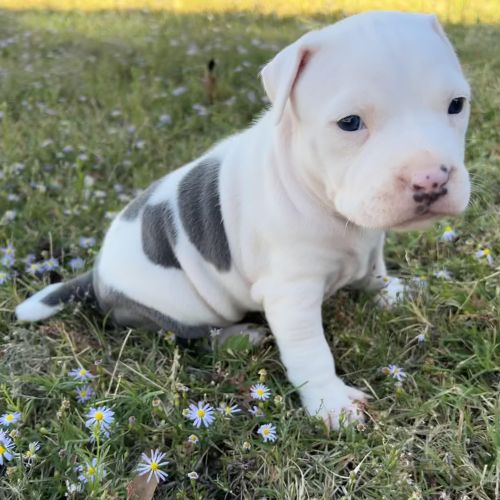
Intelligence:
Staffies are renowned for their affectionate and loyal nature. Their intelligence makes them trainable and responsive to commands. A well-socialized Amstaff is not only a devoted family member but also a reliable and confident companion.
Physical Characteristics:
Typically weighing between 50 to 70 pounds, Amstaffs have a strong and athletic build. Their short, smooth coat comes in various colors, with distinctive markings. Their expressive eyes and medium-sized ears contribute to their charming appearance. Their average height is between 17-19 inches for males and about 16-18 for females.
Behavioral Problems:
Separation Anxiety:
When it comes to behavioral problems for American Staffordshire Terriers, separation anxiety often tops the list. These loyal companions form strong bonds with their owners, and being left alone can trigger stress and anxiety.
Destructive Chewing:
Destructive chewing is another common challenge with Amstaffs. This behavior may stem from boredom, excess energy, or teething, especially in puppies.
Digging:
Digging is a natural behavior, but excessive digging can be problematic. American Staffordshire Terriers may dig due to boredom, seeking cooler ground, or responding to scents.
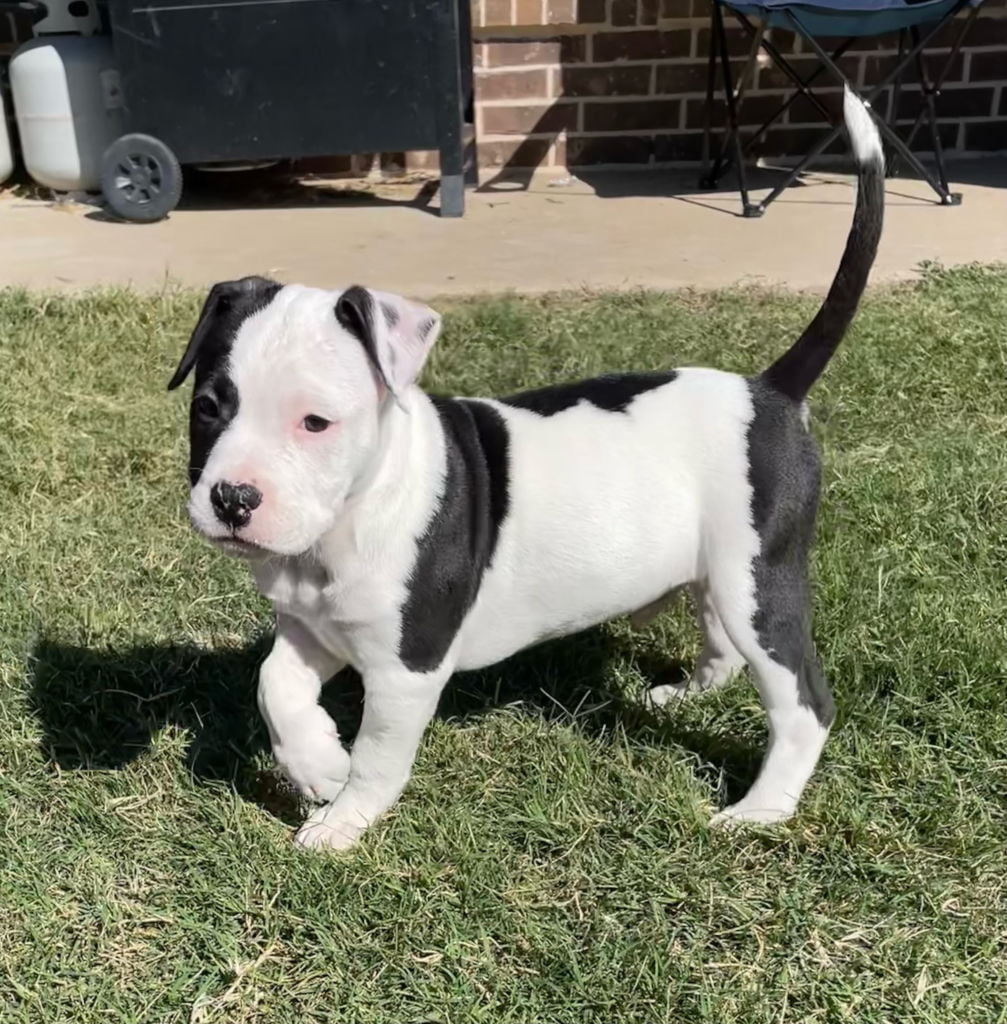
Health and Care
Common Health Considerations:
The American Staffordshire Terrier is a robust and generally healthy breed. Responsible breeders should carefully assess the health of their breeding dogs, looking out for issues like canine hip dysplasia, heart conditions, and skin and coat allergies. A recent genetic test is available to detect cerebellar ataxia, a condition that leads to a progressive loss of muscle coordination and typically manifests between 3 to 5 years of age. This test enables breeders to avoid producing puppies with this mutation, ensuring its absence in their bloodlines. Just like any breed, it’s important to regularly check the ears and maintain good dental hygiene by brushing the dog’s teeth.
The National Breed Club recommends the following tests.
- Hip Evaluation
- Neuronal Ceroid Lipofuscinosis 4A (NCL, NCL4A) – DNA Test
- Thyroid Evaluation
- Cardiac Exam
Grooming Needs:
Maintaining the short, firm coat of an American Staffordshire Terrier is quite simple. A brief once-over using a gentle bristle brush once a week typically suffices to eliminate any dirt or foreign substances. Additionally, regular brushing helps evenly distribute the dog’s natural skin oils, promoting a healthy coat. In the event that your Am Staff has a messy encounter, a bath may be necessary, but generally, baths can be postponed until you notice an “odor” associated with the dog. Like all dog breeds, it’s essential to trim the Am Staff’s nails regularly, as excessively long nails can be uncomfortable and hinder the dog’s mobility during walks and runs.
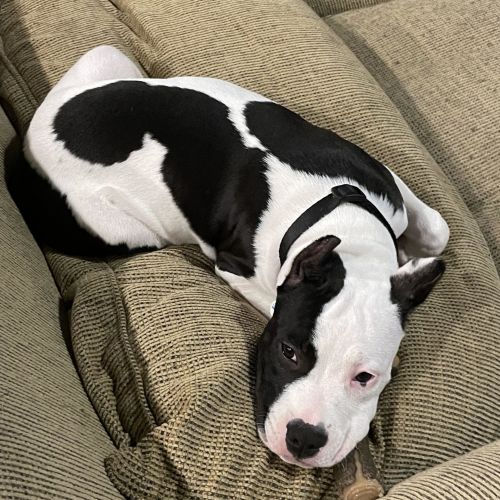
Nutritional Needs:
Understanding and meeting the nutritional needs of an American Staffordshire Terriers are paramount for their overall health and well-being. By following these feeding tips and staying attuned to your dog’s individual requirements, you’ll be ensuring a happy, healthy life for your beloved Amstaffs.
Feedings:
American Staffordshire Terriers need a diet that’s just right for medium to large-sized dogs with average energy levels. It’s important to talk to your vet to figure out the best food and portion sizes for your Amstaff. As your dog grows up, their dietary needs will change, so be sure to adjust their food from when they’re a puppy to when they are an adult.
Training and Socialization:
Positive Reinforcement Techniques:
Training Amstaffs should emphasize positive reinforcement techniques. These dogs respond well to praise and rewards, making training sessions enjoyable and effective.
Socialization Importance:
Early socialization is crucial for Amstaffs to ensure they grow into well-mannered adults. Exposing them to various environments, people, and other animals helps develop their social skills and reduces the likelihood of behavioral issues.
Exercise and Activities:
Exercise Requirements:
These are energetic dogs that require regular exercise to keep them physically and mentally stimulated. Daily walks, playtime, and interactive activities contribute to their overall well-being.
Suitable Activities:
Engaging Amstaffs in activities like agility training, obedience competitions, and interactive play sessions can harness their intelligence and energy in positive ways.
Different Colors
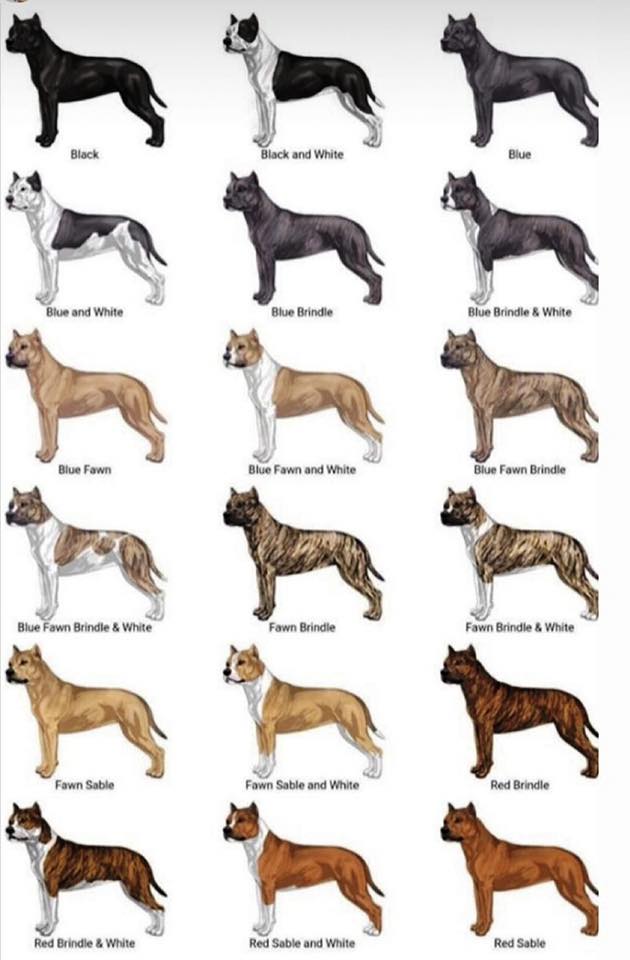
Staffordshire Terriers showcase a captivating array of coat colors that add to their individuality and allure. These dogs have short, smooth fur and display a wide spectrum of hues, making each one distinctive. You’ll often find them in colors like blue, fawn, white, black, and red. Additionally, some may even sport a combination of white with other colors or white with striking brindle patterns.
Diverse coat colors give each American Staffordshire Terrier a unique and appealing appearance. Whether they exhibit the elegant blue, the warm fawn, or the classic black and white mix, their coats enhance their inherent charm. Furthermore, when you invite an American Staffordshire Terrier into your home, you not only gain a loyal companion but also a stunning and one-of-a-kind family member with a remarkable coat.
American Staffordshire Terrier History
The history of American Staffordshire Terriers, a captivating journey through time, traces back to a fascinating blend of Bulldogs and Terrier breeds. Initially, people knew them by a variety of names such as Bull-And-Terrier Dog, Pit Bull Terrier, and Half and Half. Eventually, they eventually adopted the title of Staffordshire Bull Terriers.
Working Dogs:
Over time, these dogs proved themselves as diligent workers, collaborating with butchers in handling bulls, assisting hunters in capturing wild boars, and supporting farmers with various agricultural tasks. Their remarkable affection for humans led them to become cherished family companions.
Fighting:
Tragically, they found themselves entangled in the world of cruel sports, including bull-baiting and bear-baiting, events characterized by brutality. Fortunately, these barbaric practices were outlawed, but the dogs faced a new form of cruelty when they became participants in dog fighting, a practice that remains illegal and inhumane to this day. These unfortunate circumstances unfairly tarnished the breed’s reputation, branding them as aggressive.
Arrived in the United States:
Around 1850, a considerable number of these dogs embarked on a journey to America, where they earned new titles such as American Pit Bull Terriers, Pit Bull Terriers, American Bull Terriers, and Yankee Terriers. Renowned for their strength and tenacity, they quickly made a name for themselves.
United Kennel Club:
Moreover, the United Kennel Club embraced them as American Pit Bull Terriers in the early 1900s, while the American Kennel Club (AKC) bestowed the title of Staffordshire Terriers upon them in 1936. In 1976, the AKC opted to distinguish them further by renaming them American Staffordshire Terriers, acknowledging their slightly larger size compared to the original Staffordshire Bull Terriers. Some breeders still hold a preference for the former name.
Similarities with Pit Bull Terriers:
Today, both breeds, although separately bred for over half a century, share numerous similarities. They have evolved into beloved family pets, reliable watchdogs, and enthusiastic participants in a range of dog competitions. However, it’s essential to acknowledge that breed-specific bans persist in some regions, and certain insurance companies might not provide coverage, a consideration prospective owners should heed.
